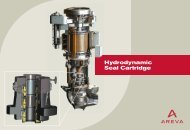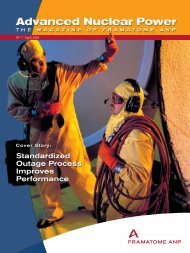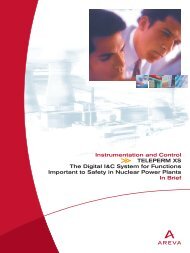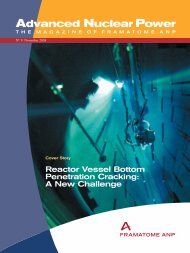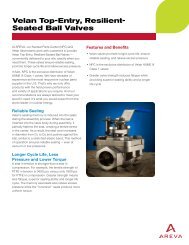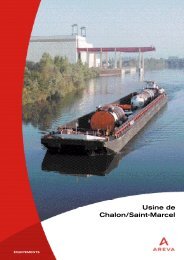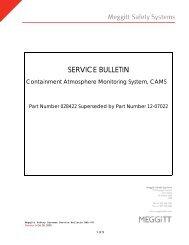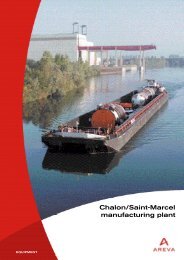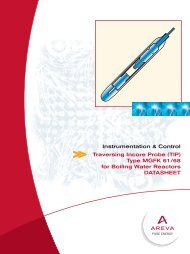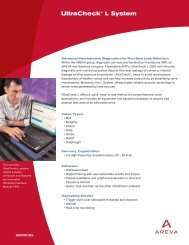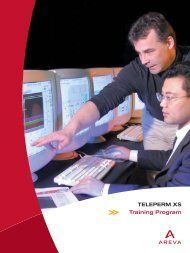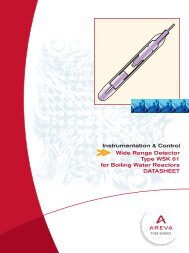EPR – Areva brochure
EPR – Areva brochure
EPR – Areva brochure
You also want an ePaper? Increase the reach of your titles
YUMPU automatically turns print PDFs into web optimized ePapers that Google loves.
■ <strong>EPR</strong> NUCLEAR ISLANDPRIMARY SYSTEM†CHARACTERISTICSDATAReactor coolant systemCore thermal power4,500 MWthNumber of loops 4Coolant flow per loop 28,330 m 3 /hReactor pressure vessel inlet temperature 295.9 °CReactor pressure vessel outlet temperature 327.2 °CPrimary side design pressure176 barPrimary side operating pressure155 barSecondary side design pressure100 barSaturation pressure at nominal conditions78 barMain steam pressure at hot standby90 barPRIMARY SYSTEM CONFIGURATIONThe <strong>EPR</strong> primary system is of a well proven 4-loop design.French 1,300 MWe and 1,500 MWe N4 reactors as well as GermanKONVOI reactors are also of 4-loop design.In each of the four loops, the primary coolant leaving the reactorpressure vessel through an outlet nozzle goes to a steam generator<strong>–</strong> the steam generator transfers heat to the secondary circuit <strong>–</strong>, thenthe coolant goes to a reactor coolant pump before returning to thereactor pressure vessel through an inlet nozzle. Inside the reactorpressure vessel, the primary coolant is first guided downward outsidethe core periphery, then it is channeled upward through the core,where it receives heat generated by the nuclear fuel.A pressurizer, part of the primary system, is connected to one of thefour loops. In normal operation, its main role is to automaticallymaintain the primary pressure within a specified range.Cattenom, France (4 X 1,300 MWe): inside a reactor building.The <strong>EPR</strong> main reactor components: reactor pressure vessel,pressurizer and steam generators feature larger volumes than similarcomponents from previous designs to provide additional benefit interms of operation and safety margins.The increased free volume in the reactor pressure vessel, betweenthe nozzles of the reactor coolant lines and the top of the core,provides a higher water volume above the core and thus additionalmargin with regard to the core “dewatering” time in the event of apostulated loss of coolant accident. Therefore, more time would beavailable to counteract such a situation.This increased volume would also be beneficial in shutdownconditions in case of loss of the Residual Heat Removal Systemfunction.Larger water and steam phase volumes in the pressurizer smooththe response of the plant to normal and abnormal operatingtransients allowing extended time to counteract accident situationsand extended equipment lifetime.The larger volume of the steam generator secondary side results inincreasing the secondary water inventory and the steam volume,which offers several advantages.• During normal operation, smooth transients are obtained and thusthe potential for unplanned reactor trips is reduced.• Regarding the management of steam generator tube rupturescenarios, the large steam volume, in conjunction with a setpoint ofthe safety valves of the steam generators above the safety injectionpressure, prevents liquid release outside the reactor containment.• Due to the increased mass of secondary side water, in case of anassumed total loss of the steam generator feedwater supply, thedry-out time would be at least 30 minutes, sufficient time to recovera feedwater supply or to decide on other countermeasures.In addition, the primary system design pressure has been increasedin order to reduce the actuation frequency of the safety valves whichis also an enhancement in terms of safety.Computer-generated imageof the <strong>EPR</strong> primary systemOVERALL FUNCTIONAL REQUIREMENTSAND FEATURESActivation of safety systemsActivation of the safety systems, including safety valves, does notoccur prior to reactor trip, which means that best possible use ismade of the depressurizing effect of the reactor trip. This approachalso ensures maximum safety by minimizing the number of valveactivations and the potential for valves sticking open after response.Preventing reactor tripReactor trip is prevented by a fast reactor power cutback to partload when one of the following events occurs:• loss of steam generator feedwater pumps, provided at least oneof them remains available,• turbine trip,• full load rejection,• loss of one reactor coolant pump.† The increased volume of the primarysystem is beneficial for smoothing overmany types of transients.† The primary system design pressure hasbeen increased to reduce the safety valveactuation frequency.† The management of steam generator tuberupture scenarios prevents any liquidrelease outside the reactor containment.† The large steam generator secondaryside water inventory increases the timeavailable to take action in case ofassumed total loss of secondaryfeedwater.14 II 15



